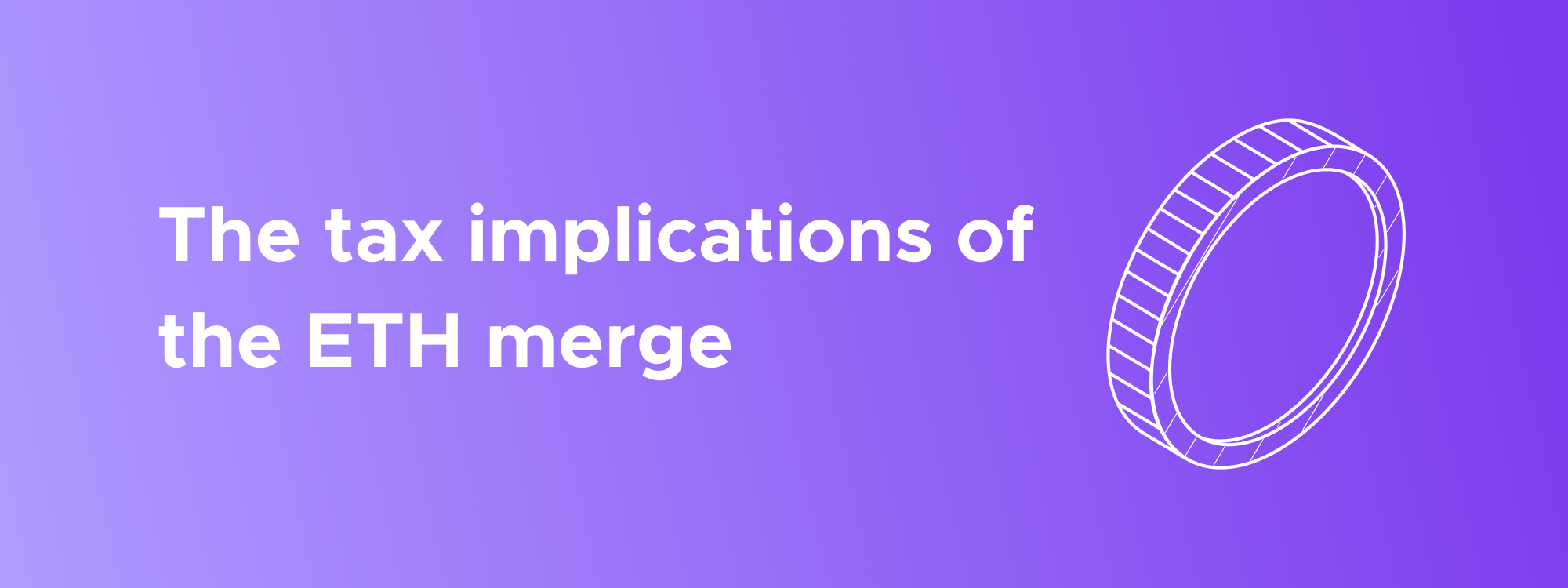Does moving to ETH 2.0 have tax implications?

ETH 2.0 is a hot topic at the moment, with crypto users around the world eagerly awaiting its introduction. Over at CTC, we’re equally as excited, but we also wanted to take the opportunity to look at how this new development could potentially impact your tax obligations. Let’s dive in!
What is ETH 2.0?
ETH 2.0 (or Ethereum 2.0) was the name given to a major upgrade to the current Ethereum mainnet. The purpose of the upgrade was to enhance the speed, efficiency, and scalability of the Ethereum network so that usage and adoption can be accelerated. Right now, the Ethereum mainnet functions on a ‘Proof-of-work’ (POW) mechanism, whereas this upgrade would transition it to functioning on a ‘Proof-of-stake’ (POS) mechanism. This switch would allow more transactions to be processed simultaneously, reducing the load on the network and the input of cryptographic computer programs. However, in January 2022, the Ethereum Foundation stated that they were no longer referring to this particular upgrade as ETH 2.0, and would instead label this move to a consensus mechanism “the Merge”.
What is the Merge?
To quote the Ethereum Foundation directly, the Merge “represents the joining of the existing execution layer of Ethereum (the Mainnet we use today) with its new proof-of-stake consensus layer, the Beacon Chain. It eliminates the need for energy-intensive mining and instead secures the network using staked ETH. A truly exciting step in realizing the Ethereum vision – more scalability, security, and sustainability.” Once the consensus layer is implemented and the Merge has been completed, the formation of new blocks and validation of transactions will no longer rely on mining. Instead, that duty will lie with validators that stake ETH to power processing on the network.
How is the Merge different from the current Ethereum setup?
Currently, the Ethereum mainnet is set up to validate transactions in the same way as the Bitcoin network: using a POW consensus mechanism. In this current state, miners use a computer to solve cryptographic puzzles in order to create new blocks and validate transactions. This approach is functional, however it processes transactions slowly and is energy intensive to the amount of processing power put into solving the cryptographic puzzles.
When the transition to POS consensus mechanism is made, users on the Ethereum network will be able to stake and/or become a validator to contribute to processing new blocks and transactions.
When is the Ethereum merge happening?
The question that is on everyone’s lips! When will the Merge happen? The answer is: no one knows for sure. set as TTD 58750000000000000000000, but the exact time cannot be predicted. Reports are circulating that it will occur in mid-September 2022, following the trial on Goerli testnet being successful. It’s a waiting game from here.
The tax implications of the Ethereum merge
Based on the technical details outlined by the Ethereum Foundation earlier in this article (”joining of the existing execution layer of Ethereum (the Mainnet we use today) with its new proof-of-stake consensus layer”), the Merge appears comparable to a soft fork. A soft fork is defined as a change to a blockchain’s protocol which is backwards-compatible, and hence doesn’t result in a diversion of the ledger, therefore not forming a new cryptocurrency (the opposite of which is a hard fork). After the Merge, you will still hold the same assets that you held prior to it being actioned.
Example: Bob holds 10 ETH on the Ethereum mainnet prior to the Merge. After the Merge, he still holds 10 ETH on the Ethereum mainnet. The only difference is that the Ethereum mainnet he holds his assets has been upgraded to use a new consensus mechanism.
The tax treatment of soft forks in Australia
The ATO has not given any specific guidance on the treatment of soft forks at the time of writing. However, they have outlined the tax implications of a chain split, another term for a hard fork. The ATO states that any assets received as a result of a chain split will have a cost basis of zero. As the Merge will not result in any new assets being distributed, you will be in the same financial position as you were before it was actioned. Using this definition, you could assume that a soft fork has no taxable implications in Australia.
The tax treatment of soft forks in the United States
The IRS has given specific guidance on the treatment of soft forks, stating that “because soft forks do not result in you receiving new cryptocurrency, you will be in the same position you were in prior to the soft fork, meaning that the soft fork will not result in any income to you.” This means you do not have any new assets to declare as part of your tax return after the Merge occurs.
The tax treatment of soft forks in the United Kingdom
The HMRC has stated that “a soft fork updates the protocol and is intended to be adopted by all. No new tokens, or distributed ledger, are expected to be created.” If there are no new assets or ledger created, it can be assumed that there can be no additional taxes applied.
As always when there is a lack of specific guidance for a particular crypto event such as the Ethereum Merge, we recommend talking to a local tax professional to determine how best to approach the situation.
How Crypto Tax Calculator can help
In an event like the Ethereum Merge, there are no user-level transactions needed to ‘opt-in’ to the updated protocol, it just happens. The way Crypto Tax Calculator can help is by giving you the means to track your crypto transaction activity, regardless of what chain, exchange or wallet you’re interacting with. Try it out for yourself.
Disclaimer: The content of this guide is for general informational purposes only. It is not legal or tax advice. Viewing this guide, purchasing or using Crypto Tax Calculator does not create an attorney-client relationship or a tax advisor-client relationship.
The information in this guide represents the opinions of experienced crypto tax professionals; however, some of the topics in this guide are still subject to debate amongst professionals, and tax authorities could ultimately release guidance that conflicts with the information in this guide. The information contained in this guide is based on the authors’ interpretation of current guidelines. Changes to the guidelines may be retroactive and could significantly alter the views expressed herein. Therefore, use this information at your own risk and for information purposes only.
Consult a professional regarding your individual tax or legal situation.!


